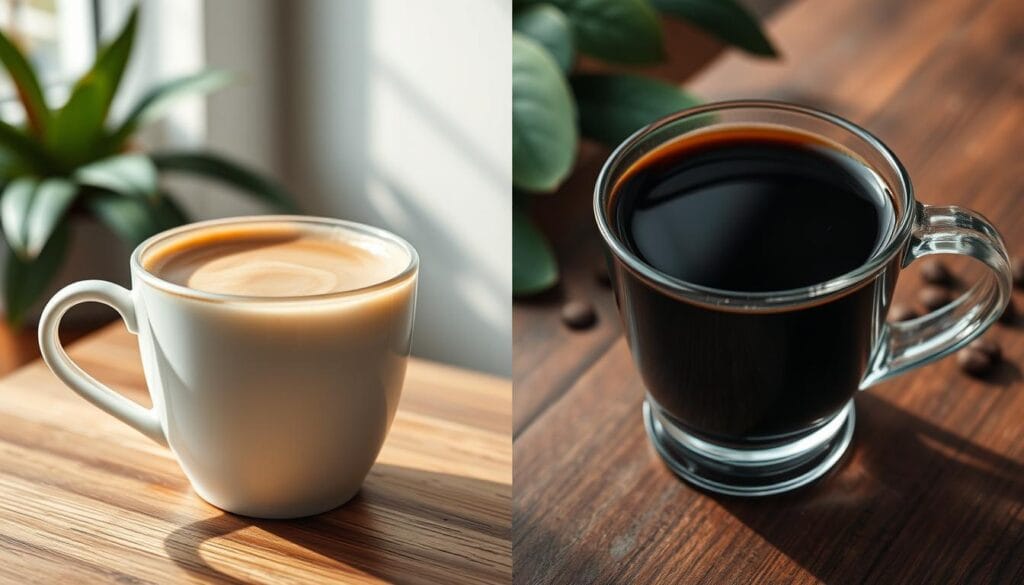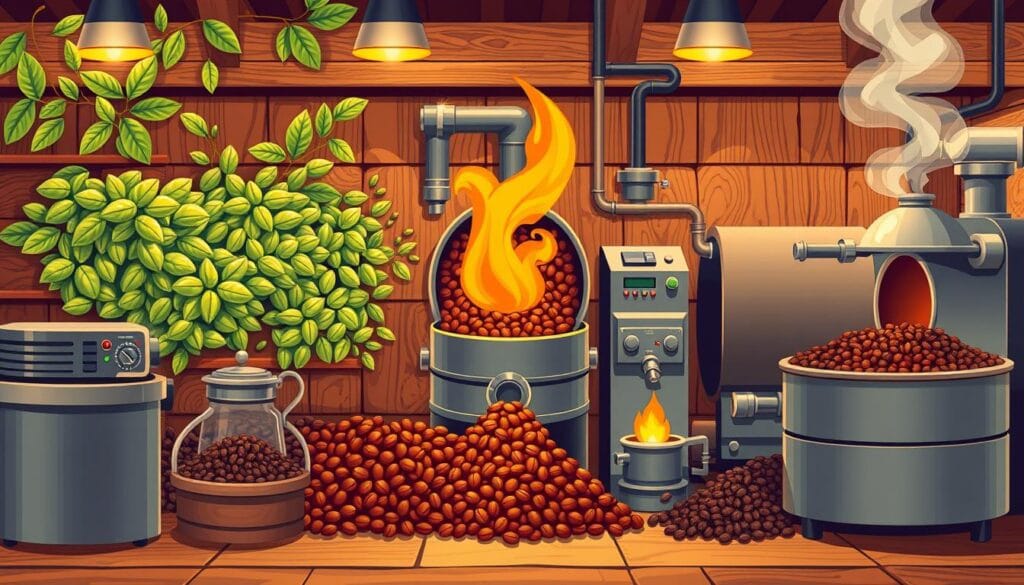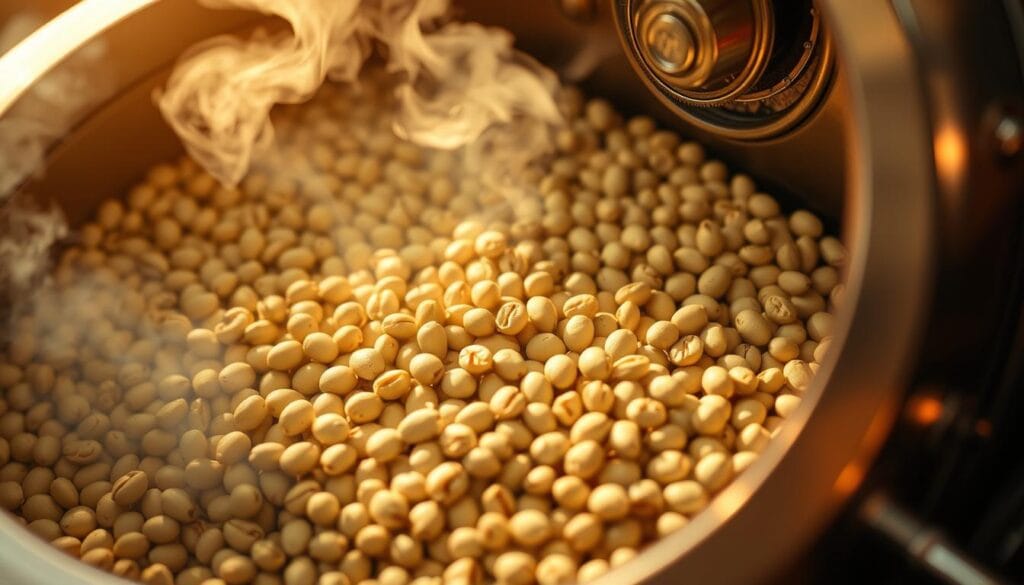Every morning, the rich aroma of coffee fills my kitchen. It reminds me of the amazing journey coffee beans take before they reach my mug. The world of coffee is complex, with white and black coffee being two interesting extremes.

Exploring roasting methods shows that white and black coffee have different flavors. These varieties aren’t just about color. They show different ways to turn raw coffee beans into the drink we all love.
Whether you drink coffee casually or are very into it, knowing the differences between white and black coffee can make your brewing better. From how they’re roasted to their tastes, each type has its own story to tell in your cup.
Key Takeaways
- White coffee and black coffee differ significantly in roasting methods
- Each variety offers unique flavor profiles and taste experiences
- Roasting time and temperature dramatically impact coffee characteristics
- Understanding coffee varieties helps enhance personal brewing choices
- Coffee is more than a beverage – it’s a complex culinary art
Understanding the Fundamentals of Coffee Roasting
Coffee roasting turns simple coffee beans into the aromatic drink you love. It’s a mix of science, temperature, and timing. This process turns green coffee beans into rich, flavorful treasures.

The journey of coffee beans starts long before they reach your cup. Roasting changes the bean’s physical and flavor characteristics in a complex way.
The Science Behind Bean Transformation
During roasting, coffee beans go through big molecular changes. These changes include:
- Moisture reduction
- Color change from green to brown
- Development of complex flavor compounds
- Release of aromatic oils
Temperature and Time Variables
Artisanal roasting needs careful control of temperature and time. Different roasting profiles give unique flavor experiences.
| Roast Level | Temperature Range | Typical Roasting Time |
|---|---|---|
| Light Roast | 350-400°F | 3-5 minutes |
| Medium Roast | 410-430°F | 5-7 minutes |
| Dark Roast | 440-460°F | 8-10 minutes |
Chemical Changes During Roasting
As coffee beans heat up, they go through the Maillard reaction. This complex chemical process creates hundreds of flavor compounds. It transforms simple sugars and amino acids into rich, nuanced tastes that define your coffee experience.
“Roasting is where science meets art in creating the perfect cup of coffee.” – Coffee Master Roaster
What Makes WHITE COFFEE Unique

White coffee is a unique twist in the coffee world. It’s different from dark roasts, offering a special experience for coffee lovers. This light roast method keeps more of the bean’s natural traits.
The defining features of white coffee include:
- Extremely light roasting at lower temperatures
- Minimal roasting time compared to standard coffee methods
- Retention of more natural bean nutrients
Tasting white coffee, you’ll find its smooth taste and unique flavor. The light roast makes it low in acidity, easier on your stomach. Health-conscious people are drawn to it for a milder coffee.
“White coffee represents a revolutionary approach to coffee brewing, challenging traditional roasting methods.” – Coffee Research Institute
White coffee stands out with its:
- Lighter color and appearance
- Nutty, less bitter flavor profile
- Higher caffeine content
- Reduced oxidation during roasting
Exploring white coffee can enrich your coffee experience. It’s perfect for both casual and serious coffee fans. This innovative method offers a refreshing change from traditional coffee.
Traditional Black Coffee Characteristics
Black coffee is a pure coffee experience that many love. It has a complex flavor and character.
The taste of black coffee comes from roasting and extraction. Roasting methods change the taste, offering different experiences.
Flavor Profile Development
To understand black coffee’s taste, we need to look at a few things:
- Bean origin and genetic characteristics
- Roasting duration and temperature
- Grinding consistency
- Brewing method
Aromatic Compounds
Aromatic compounds are key in black coffee’s taste. They create the aroma that coffee fans enjoy.
“The magic of black coffee lies in its complex aromatic landscape” – Coffee Experts Collective
Oils and Extractions
Roasting releases oils from coffee beans, adding to the flavor. These oils bring out the rich taste and smoothness of good black coffee.
The way these oils are extracted affects your coffee. It changes the body and intensity of the taste.
The Roasting Process Comparison
The roasting process turns green coffee beans into the aromatic delights we love. White coffee and traditional black coffee have different roasting methods. These methods affect flavor, aroma, and the overall coffee experience.
Artisanal roasting techniques are key in defining each coffee type’s unique characteristics. White coffee has a different roasting approach than traditional black coffee:
- Light roast for white coffee: Beans are roasted at much lower temperatures
- Shorter roasting duration: Minimal heat exposure preserves unique flavor profiles
- Reduced caramelization: Maintains a lighter color and distinct taste characteristics
Traditional black coffee roasting uses more heat. The roasting process for black coffee includes:
- Higher temperature roasting (usually between 370-540°F)
- Longer roasting times allowing deeper flavor development
- Complete caramelization of sugars in the bean
“The magic of coffee lies in its transformation through heat – each degree changes the entire flavor profile.” – Coffee Roasting Experts
Your choice between white and black coffee depends on your taste preferences. The light roast of it offers a unique experience. It’s different from traditional roasting techniques.
Knowing these roasting differences helps us appreciate the craft behind our favorite coffee drinks.
Caffeine Content and Health Benefits
Coffee lovers often ask about its health effects. Knowing the caffeine and health benefits helps you choose your coffee wisely.
But coffee is more than a morning boost. Both white and black coffee have health perks beyond caffeine.
Antioxidant Properties
Antioxidants protect your body from free radicals. Coffee is full of these good guys:
- White coffee has more chlorogenic acid
- Black coffee has a wider range of antioxidants
- Lighter roasts keep more antioxidants from the bean
Digestive System Effects
White and black coffee affect your stomach differently. Lighter roasts are often less acidic, easing stomach issues.
| Coffee Type | Acidity Level | Digestive Impact |
|---|---|---|
| White Coffee | Lower | Gentler on stomach |
| Black Coffee | Higher | Potential digestive stress |
Energy Impact Differences
Caffeine levels differ in white and black coffee, affecting energy. White coffee often has more caffeine, giving a longer energy lift.
“Not all coffee is created equal – the roasting process dramatically impacts both flavor and health benefits.” – Coffee Research Institute
Your choice depends on health goals, taste, and caffeine sensitivity.
Brewing Methods and Recommendations
Exploring the right brewing methods can change your specialty coffee experience. Different techniques bring out unique flavors in white and black coffee. This makes your morning ritual more than just a caffeine boost.
Artisanal roasting techniques offer many brewing approaches. Each method highlights a coffee’s unique characteristics. Your choice of method greatly affects taste, aroma, and enjoyment.
- Pour-Over Method: Ideal for specialty coffee, offering precise extraction
- French Press: Best for robust, full-bodied coffee experiences
- Cold Brew: Smooth extraction with lower acidity
- Espresso: Concentrated brewing for intense flavor profiles
Water temperature is key in brewing methods. For white coffee, use lower temperatures of 185-195°F. This preserves delicate flavors. Black coffee can handle higher temperatures up to 200-205°F, allowing for deeper extraction.
| Brewing Method | White Coffee Recommendation | Black Coffee Recommendation |
|---|---|---|
| Pour-Over | Light roast, gentle extraction | Medium to dark roast |
| French Press | Coarse grind, shorter steeping | Longer steeping time |
| Espresso | Quick extraction | Standard pressure extraction |
“The perfect brew is an art form – respect the bean, master the technique.” – Coffee Artisan
Your brewing equipment is also important. Invest in quality grinders, precise kettles, and clean filters. This will improve your specialty coffee experience. Remember, each brewing method tells a different story in the same coffee bean.
Flavor Profiles and Taste Experience
Coffee lovers know that flavor profiles are more than just taste. White coffee and black coffee give unique sensory experiences. They can change how you enjoy your daily coffee.
Your coffee journey is all about the subtle differences. These differences define the smooth taste and unique flavors. Each brewing method and roast level adds to the cup’s complexity.
Acidity Levels
Acidity is key in coffee’s flavor. Roasting techniques change the acid levels:
- White coffee has lower acidity
- Black coffee has more acidic notes
- Roasting time affects acid levels
Body and Mouthfeel
The way coffee feels on your tongue is complex. Mild flavors come from careful brewing.
| Coffee Type | Body Characteristics | Mouthfeel Intensity |
|---|---|---|
| White Coffee | Light and delicate | Smooth, subtle |
| Black Coffee | Full-bodied and rich | Robust, pronounced |
Aftertaste Characteristics
“The true art of coffee is discovered in its lingering essence.” – Coffee Master
The aftertaste shows the flavor journey of your coffee. White coffee has a cleaner, less intense finish. Black coffee leaves a more complex and lasting taste.
- White coffee: Gentle, quick-dissipating taste
- Black coffee: Deep, resonant aftertaste
Bean Selection and Origins
Exploring coffee beans means learning about their origins. This is key to enjoying specialty coffee. The journey of a great cup begins with picking beans from certain places.
Each coffee-growing area has its own special traits. These traits greatly affect the taste of the coffee. Choosing the right coffee beans can turn a simple drink into a rich experience.
Key Coffee Bean Origins
- Ethiopian Yirgacheffe: Floral and delicate notes
- Colombian Supremo: Balanced and smooth flavor
- Guatemalan Antigua: Rich, complex taste
- Sumatran Mandheling: Earthy and full-bodied
Artisanal roasting brings out these unique flavors. Coffee experts pick beans that show off the region’s taste. This is called terroir.
“Great coffee is not made, it’s carefully cultivated from seed to cup.” – Specialty Coffee Expert
Factors Influencing Bean Quality
- Altitude of coffee plantation
- Soil composition
- Local climate conditions
- Harvesting and processing methods
Knowing these details can make your coffee experience better. It turns a simple drink into a journey of flavors and skill.
Storage and Shelf Life Differences
Coffee lovers know that keeping coffee fresh is key. Both white and black coffee need the right storage to stay great. Knowing how to store coffee can really affect its freshness and how long it lasts.
The place where you store your coffee is very important. It affects the coffee’s taste. Several factors can change how your coffee tastes.
Optimal Storage Conditions
To keep your coffee fresh, follow these tips:
- Keep coffee in an opaque, airtight container
- Store in a cool, dark place away from direct sunlight
- Maintain consistent temperature between 50-70°F
- Avoid moisture and humidity exposure
Freshness Indicators
Knowing when coffee is fresh is important. Here’s how to tell:
| Indicator | White Coffee | Black Coffee |
|---|---|---|
| Peak Freshness | 2-3 weeks after roasting | 1-2 weeks after roasting |
| Aroma Intensity | Mild, nutty | Strong, robust |
| Color Changes | Minimal | More noticeable oxidation |
Pro tip: Always buy coffee in small amounts for the best taste.
“Fresh coffee is like a fine wine – its quality deteriorates quickly without proper care.” – Coffee Preservation Expert
Using these storage tips will help keep your coffee’s unique taste. You’ll enjoy a better coffee experience every time.
Popular Brewing Applications
Exploring specialty coffee shows us many brewing methods. Each method brings out the best in white and black coffee. Your coffee experience changes with the brewing technique you pick.
Different brewing methods reveal unique flavors in artisanal roasting. Each method highlights different qualities in your coffee. This makes choosing a brewing method a fun culinary journey.
- Pour-Over Method: Ideal for specialty coffee enthusiasts seeking clarity and precision
- French Press: Delivers rich, full-bodied extraction for darker roasts
- Cold Brew: Perfect for smooth, low-acid coffee experiences
- Espresso: Concentrates intense flavors in a compact serving
“The art of brewing is about understanding your coffee’s unique personality.” – Professional Barista
White coffee, with its lighter roast, does well with gentle brewing. Drip and pour-over methods show off its delicate flavors. Black coffee, being stronger, shines in methods that bring out deep, complex tastes.
| Brewing Method | White Coffee Suitability | Black Coffee Suitability |
|---|---|---|
| Pour-Over | Excellent | Good |
| French Press | Limited | Exceptional |
| Cold Brew | Moderate | Excellent |
Your choice of brewing method depends on what you like and how intense you want the flavor. Try different methods to find your ideal coffee experience.
Making the Right Choice for Your Palate
Choosing the right coffee is about knowing what you like and how you live. White coffee and black coffee are two different ways to enjoy coffee. They suit different tastes and lifestyles.
Your coffee choice is based on your taste and lifestyle. It’s about finding what works best for you.
Understanding Your Taste Preferences
Think about these important taste factors when picking coffee:
- Smooth taste intensity
- Caffeine sensitivity
- Flavor complexity
- Brewing method compatibility
Lifestyle Factors to Consider
Our lifestyles affect how we like our coffee. Look at your daily life:
| Lifestyle Type | Recommended Coffee | Rationale |
|---|---|---|
| Active Professional | White Coffee | Lighter roast, smoother taste |
| Fitness Enthusiast | Black Coffee | Higher antioxidant content |
| Casual Coffee Drinker | Blend Preference | Versatile flavor profile |
“Coffee is not just a drink. It’s a personal experience that reflects your unique lifestyle and taste preferences.” – Coffee Enthusiast
Try different coffees to find the one that fits your taste and lifestyle.
Conclusion
White coffee and black coffee are two different paths in coffee exploration. Your taste preferences will help you choose between these roasting methods and flavors. By understanding their differences, you can make your coffee experience even better.
The roasting process is key to your coffee’s taste. White coffee has a lighter flavor and more caffeine. Black coffee, on the other hand, is rich and robust. Each style adds something special to your coffee time.
Your coffee adventure is about finding what you like. You might prefer white coffee’s subtle notes or black coffee’s deep flavors. Try different brewing methods and roasts to find your favorite.
What exactly is white coffee?
Coffee is more than a drink; it’s a blend of culture, science, and taste. Enjoy the variety of coffee and let your taste guide you. This journey is full of delightful flavors and aromas.
FAQs: White Coffee & Black Coffee
White coffee is made from beans roasted at lower temperatures for a short time. This gives it a light color and a smooth, mild taste. It has more caffeine and less acidity than dark roasts, making it a gentle coffee choice.
How does white coffee differ from regular black coffee?
White coffee is roasted at about 325°F, while black coffee is roasted at 450-480°F. This makes white coffee lighter, smoother, and more caffeinated. It also has less acidity than dark roasts.
Is white coffee stronger in terms of caffeine?
Yes, white coffee has more caffeine than dark roasts. The lower roasting temperature and shorter time mean more caffeine is kept. This makes it a great choice for those who want a caffeine boost without bitterness.
How should I brew white coffee?
Brew white coffee with methods that highlight its unique flavor. Espresso machines or pour-over methods with cooler water work well. Use very fine grounds for the best results, especially in lattes and cappuccinos.
Does white coffee taste different from traditional coffee?
Yes, it does. White coffee tastes mild and nutty, with less bitterness. Its minimal roasting preserves more of the bean’s natural taste, unlike darker coffees.
Are there health benefits to drinking white coffee?
Yes, there are. White coffee’s lower roasting keeps more antioxidants and chlorogenic acids. It’s easier on your stomach and gives a longer energy boost than dark roasts.
How should I store white coffee beans?
Store white coffee beans in an airtight container, away from sunlight, heat, and moisture. It’s more delicate than dark roasts. Keep it cool and dark, and use it within 2-3 weeks for the best flavor.
Can I use white coffee in my regular coffee maker?
You can, but specialized brewing methods bring out its best. Espresso machines, pour-over, and French presses work well. If using a drip coffee maker, grind the beans finely and adjust your brewing for the best taste.


4 thoughts on “White Coffee vs. Black Coffee – Key Differences in Taste and Roast”